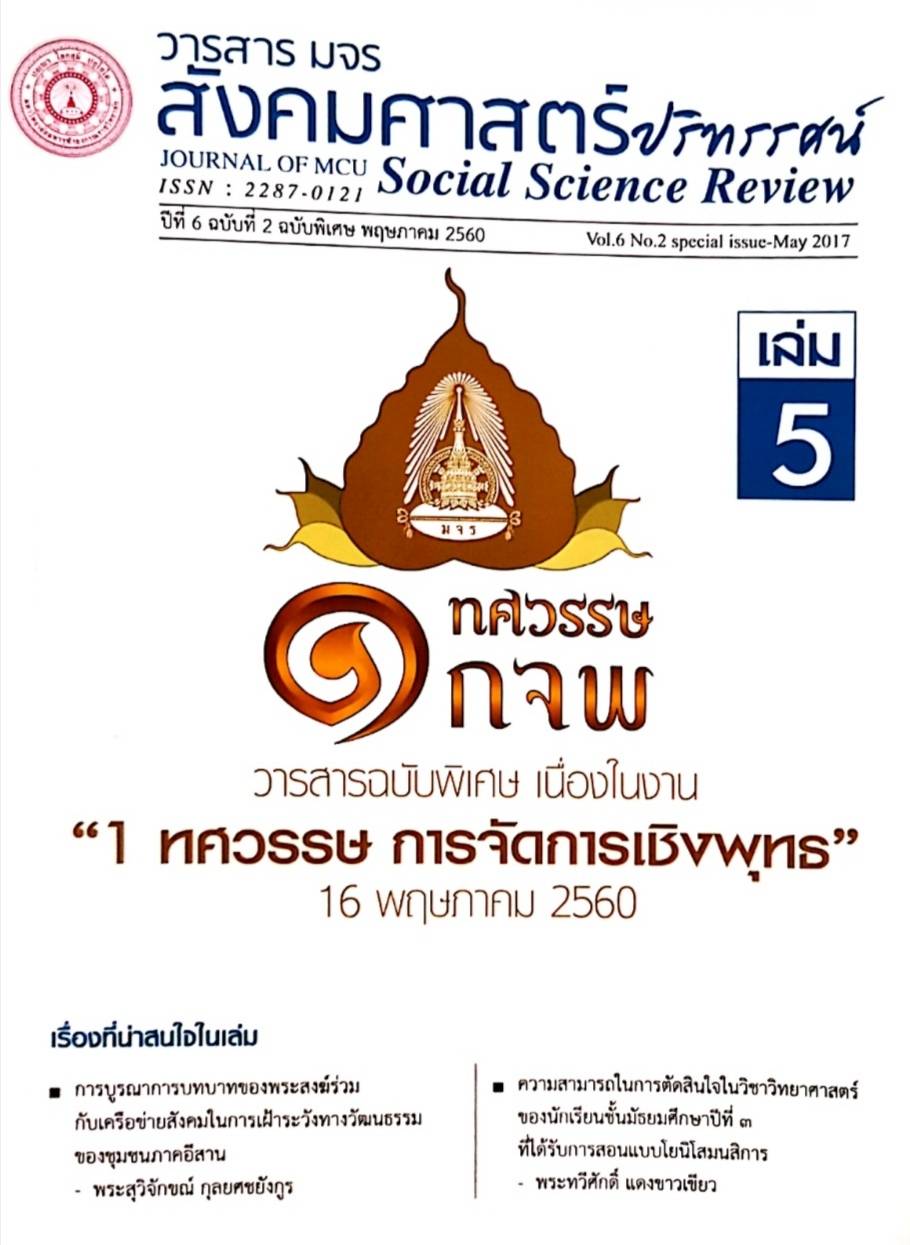การศึกษาวิเคราะห์พัฒนาการโครงสร้างพระมหาปิฎกไทโช
บทคัดย่อ
จุดม่งหมายทางวิชาการของงานวิจัยเรื่อง “การศึกษาวิเคราะห์พัฒนาการโครงสร้างพระมหาปิฎกไทโช” เพื่อการศึกษาค้นหาความรู้ความเข้าใจประวัติความเป็นมาของพระมหาปิฎกไทโช ธรรมชาติของลักษณะโครงสร้าง สิ่งที่ปรากฏในโครงสร้าง เช่น การจัดปิฎกต่างๆ ลำดับวิธีการเรียงหมวดหมู่ แม้ว่าพระมหาปิฎกไทโชจัดพิมพ์ขึ้นในประเทศญี่ปุ่นด้วยอักษรจีนจะมิใช่พระมหาปิฎกฉบับล่าสุดของพระพุทธศาสนามหายาน แต่ก็เป็นพระมหาปิฎกที่นักวิชาการพุทธศาสนาทั่วโลกต่างยอมรับเป็นแหล่งอ้างอิงข้อมูลที่ดีเท่าที่มีในปัจจุบัน โดยเริ่มพิมพ์เมื่อปี ค.ศ. 1924 เสร็จสมบูรณ์ในปี ค.ศ. 1934 บรรจุเป็นรูปเล่มจำนวน 100 เล่ม
วิธีวิจัยของรายงานวิจัยนี้ใช้รูปแบบการศึกษาวิเคราะห์เอกสาร โดยมีกระบวนการที่เริ่มต้นจาการศึกษาเก็บรวบรวมข้อมูล, วิเคราะห์ข้อมูลโดยใช้การศึกษาวิจัยเชิงชาติพันธุ์วรรณนา รูปแบบการเก็บรวบรวมข้อมูลในหลายแหล่งด้วยวิธีการอ่านแล้วแปล บันทึกเป็นกระบวนการวิเคราะห์อย่างต่อเนื่อง ซึ่งเป็นลักษณะพิเศษของการศึกษาวิจัยเชิงชาติพันธุ์วรรณนา เป็นการวิเคราะห์ที่นำมาใช้ในการศึกษาลักษณะโครงสร้างในพระมหาปิฎกไทโชบนฐานความเชื่อ ทัศนคติ ค่านิยม ศาสนา ภาษาและวัฒนธรรม
งานวิจัยนี้สามารถสรุปพัฒนาการของพระมหาปิฎกไทโชส่วนที่เป็นลักษณะโครงสร้างคัมภีร์ตั้งแต่เล่มที่ 1 ถึงเล่มที่ 85 ตามการแบ่งหมวดหมู่ พระมหาปิฎกไทโชมีโครงสร้างคัมภีร์ที่สร้างขั้นอย่างเจาะจงเพื่อสื่อความหมายเป็นสามปิฎกใหญ่ คือคัมภีร์ส่วนที่ปริวรรตเป็นภาษาจีนจากคัมภีร์ฝ่ายอินเดียดั้งเดิม คัมภีร์ปิฎกส่วนที่เป็นผลงานประพันธ์อรรถาธิบายฝ่ายจีน และคัมภีร์ปิฎกที่เป็นผลงานประพันธ์อรรถาธิบายเพิ่มเติมของฝ่ายญี่ปุ่น รวมเป็นคัมภีร์สามปิฎก ซึ่งในงานวิจัยนี้จะใช้คำว่า “อินเดียปิฎก” “จีนปิฎก” “ญี่ปุ่นปิฎก” ตามลำดับ ฉะนั้นจึงสามารถรวมเรียกได้ว่า “พระไตรปิฎก” ในลักษณะเช่นนี้ยอมสอดคล้องตามความหมายเชิงชาติพรรณวรรณนา ในปิฎกแรกประกอบด้วย 16 หมวด คือ สิบหมวดแรกในกลุ่มพระสูตร, หมวดพระวินัย, หมวดอรรถกถาพระสูตร, หมวดอภิธรรม, หมวดมาธยมิก, หมวดโยคาจาร, และหมวดรวมศาสตร์ สำหรับปิฎกที่สองและที่สามประกอบด้วยงานประพันธ์อรรถาธิบายสามหมวดหลักได้แก่อรรถาธิบายพระสูตร อรรถาธิบายพระวินัย อรรถาธิบายศาสตร์, และคัมภีร์ของนิกายต่างๆ เป็นต้น ซึ่งแบ่งออกเป็น 10 หมวด และ 5 หมวดตามลำดับ ในพระมหาปิฎกไทโชมีคำเรียกชื่อเฉพาะแก่อรรถาธิบายเหล้านี้ว่า “วิภาษา” ซึ่งในงานวิจัยนี้จะใช้คำรวมทั่วไปว่า “ปกรณ์” หรือ “ปกรณ์วิเศษ” เพี่อแสดงให้เห็นชัดเจนว่าเป็นจากงานประพันธ์ใน จีน เกาหลี และญี่ปุ่น แตกต่างจากงานประพันธ์อรรถกถาฝ่ายอินเดีย
แม้พระสูตรหรือคัมภีร์ที่บรรจุในพระมหาปิฎกไทโชจะอาศัยพื้นฐานจากพระปิฎกจีนที่มีการรวมรวมพระสูตรคัมภีร์ตั้งแต่สมัยราชวงศ์จิ้น จนถึงพระไตรปิฎกฉบับจือฝูแห่งราชวงศ์ซ่ง พระปิฎกฉบับผู่หนิงแห่งราชวงศ์หยวน พระปิฎกฉบับเจียซิงแห่งราชวงศ์หมิง และพระปิฎกฉบับเกาหลี เป็นฐานสำคัญ แต่วิธีการแบ่งหมวดหมู่พระปิฎกไทโชได้มีการแก้ไขปรับปรุงเป็นรูปแบบแตกต่างจากการแบ่งหมวดหมู่พระปิฎกพระพุทธศาสนาภาษาจีนที่สืบทอดมา โดยไม่มีการแบ่งแยกเป็นฝ่ายมหายานสาวกยานอีก นับได้ว่าไม่มีพระปิฎกฉบับใดเป็นฐานสะท้อนให้สำหรับอ้างอิงต่อวิธีการแบ่งหมวดหมู่เช่นนี้ ดังนั้นการจัดหมวดหมู่ในรูปแบบใหม่ทั้งหมดนี้เป็นเอกลักษณ์เฉพาะของพระมหาปิฎกไทโช พระมหาปิฎกไทโชได้แสดงให้เห็นถึงความเชื่อและแนวคิดแบบใหม่ที่อาศัยลำดับเหตุการณ์ทางเวลา ซึ่งสามารถค้นหาร่องรอยจากหลักฐานทางประวัติศาสตร์พระพุทธศาสนาอินเดียมากกว่าคำสอนที่สืบทอดมาในนิกายเทียนไถ เพราะสองนักปราชญ์สำคัญทางพระพุทธศาสนาชาวญี่ปุ่นคือ ทะคะคุสุ จุนิจิโร และวะตะนาเบะ ไคเคียวคุ ผู้มีบทบาทอย่างมากในการจัดทำพระมหาปิฎกไทโชได้รับวิธีการศึกษาแบบใหม่จากประเทศตะวันตกเมื่อต้นศตวรรษที่ยี่สิบได้รับอิทธิผลแนวคิดต่อคุณค่าทางศาสนา จึงทำให้เกิดความเปลี่ยนแปลงโครงสร้างดังที่ได้แสดงไว้ในพระมหาปิฎกไทโช
อีกประการหนึ่งงานวิจัยนี้ได้ปริวรรตบัญชีรายชื่อพระสูตรคัมภีร์พุทธศาสนาส่วนผลงานประพันธ์ฝ่ายอินเดีย หรือ “อินเดียปิฎก” ที่บรรจุในพระมหาปิฎกไทโชเป็นภาษาไทยด้วยชื่อคัมภีร์สันสกฤต ในกรณีชื่อพระสูตรหรือคัมภีร์ที่ไม่สามารถค้นพบร่องรอยภาษาสันสกฤตจะปริวรรตเป็นภาษาไทยโดยถอดเสียงจากภาษาจีนพร้อมกับแปลความหมายกำกับไว้ในวงเล็บต่อท้าย นอกจากนี้แล้ว งานวิจัยนี้ยังได้นำเสนอบทนำและสรุปสาระสำคัญของพระสูตรคัมภีร์สำคัญๆโดยย่อ พร้อมทั้ง แผนภูมิโครงสร้างคัมภีร์พระมหาปิฎกไทโช

เอกสารอ้างอิง
_________. (2550). ศาสตร์และศิลป์แห่งการวิจัยเชิงคุณภาพ. พิมพ์ครั้งที่ 3. กรุงเทพฯ: อมรินทร์ พริ้นติ้งแอนด์พับลิชชิ่ง จำกัด (มหาชน),.
นิศา ชูโต. (2548). การวิจัยเชิงคุณภาพ. พิมพ์ครั้งที่ 3. กรุงเทพฯ: พริ้นต์โพร จำกัด
อลิศรา ศิริศรี. (2541)."การนำวิธีวิจัยเชิงชาติพันธ์วรรณนามาใช้ในการวิจัยทางการศึกษา" รวม บทความทางวิธีวิทยาการวิจัย เล่ม 1. บรรณาธิการโดย สมหวัง พิธิยานุวัฒน์. พิมพ์ครั้งที่ 1. กรุงเทพมหานคร: จุฬาลงกรณ์มหาวิทยาลัย.
《大正藏新修大藏经》พระมหาปิฎกไทโชLi Fu-hua. He Mei. (2003). 汉文佛教大藏经研究 [Hanwen Fojiao Dazangjing Yanjiu] (Research on the Chinese Tripitaka). Beijing: Religious Culture Publishing.
ดาวน์โหลด
เผยแพร่แล้ว
รูปแบบการอ้างอิง
ฉบับ
ประเภทบทความ
สัญญาอนุญาต
ลิขสิทธิ์ (c) 2020 วารสาร มจร สังคมศาสตร์ปริทรรศน์

อนุญาตภายใต้เงื่อนไข Creative Commons Attribution-NonCommercial-NoDerivatives 4.0 International License.
เพื่อให้เป็นไปตามกฎหมายลิขสิทธิ์ ผู้นิพนธ์ทุกท่านต้องลงลายมือชื่อในแบบฟอร์มใบมอบลิขสิทธิ์บทความให้แก่วารสารฯ พร้อมกับบทความต้นฉบับที่ได้แก้ไขครั้งสุดท้าย นอกจากนี้ ผู้นิพนธ์ทุกท่านต้องยืนยันว่าบทความต้นฉบับที่ส่งมาตีพิมพ์นั้น ได้ส่งมาตีพิมพ์เฉพาะในวารสาร มจร สังคมศาสตร์ปริทรรศน์ เพียงแห่งเดียวเท่านั้น หากมีการใช้ภาพหรือตารางหรือเนื้อหาอื่นๆ ของผู้นิพนธ์อื่นที่ปรากฏในสิ่งตีพิมพ์อื่นมาแล้ว ผู้นิพนธ์ต้องขออนุญาตเจ้าของลิขสิทธิ์ก่อน พร้อมทั้งแสดงหนังสือที่ได้รับการยินยอมต่อบรรณาธิการ ก่อนที่บทความจะได้รับการตีพิมพ์ หากไม่เป็นไปตามข้อกำหนดเบื้องต้น ทางวารสารจะถอดบทความของท่านออกโดยไม่มีข้อยกเว้นใดๆ ทั้งสิ้น





